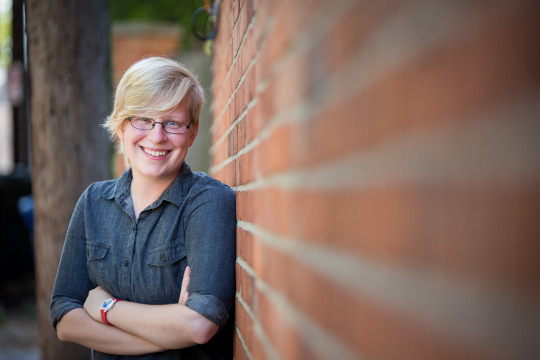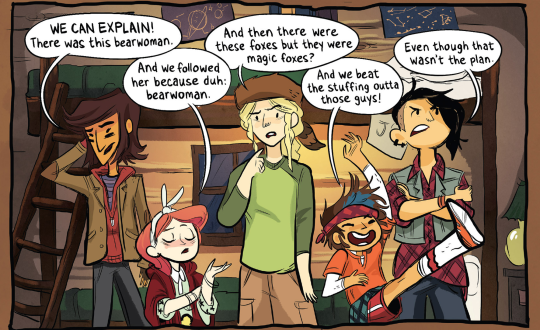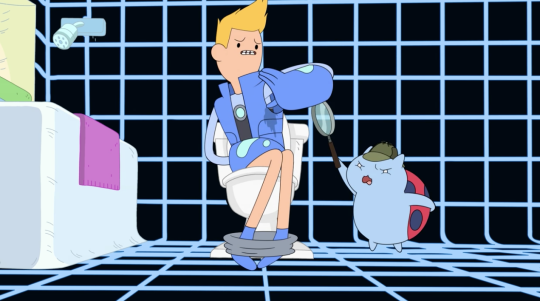
Grace Ellis is among the most exciting comic and TV writers working today, and all from coffee shops ‘round Columbus, Ohio. The first comic she created, Lumberjanes, is a NY Times bestselling series, in development as a movie, and brought her home Eisner and GLAAD awards for her cat to try to knock over. Grace is currently writing one of the most magical comics of the year, Moonstruck, but still found time to pen some awesome episodes of Bravest Warriors season 4 (after she determined that the gig was not, indeed, a prank). Grace and I sat down to talk log-doodling, queer representation in comics, and the commonalities between Beth Tezuka and Captain America.
Having written Lumberjanes: were you a Girl Scout yourself?
For a little, until my troop disbanded! Lumberjanes re-connected me with my Girl Scout roots. The inspiration for a lot of the woodsy stuff comes from an outdoor camp I was part of. After college I worked for Autostraddle, the biggest online network for queer women. They host a weeklong sleepaway camp every year called A-Camp. It has a bunch of panels, talent shows, activities – really cool stuff. When I was a camp counselor one year in Big Bear, I made friends with an attendee, Shannon Watters, who’s a writer and editor at Boom! Comics. Later, she approached me about making a comic together.
Wow! So Lumberjanes was your very first comic… ever?!
Yup! The first issue of Lumberjanes was the first comic I ever wrote.

That’s amazing! Wait, backin’ up – what were you doing before?
My big kid job was journalism. I studied a mix of journalism, theater and women’s studies at Ohio State. After school ended I started pitching around and got a gig writing ads for Playbill. Then I got some work with Bustle too. I was doing sort of garbage writing: mostly TV recaps and some vaguely personal stuff here and there. Very little actual journalism. Then I got the job with Autostraddle when the site was still fairly new.
So you taught yourself both comic writing and screenwriting?
Pretty much! I was already familiar with story structure, so it was really about learning to adapt those elements to different formats, and take advantage of each medium. That comes with practice more than teaching. Every format is different. Like with comics, I go panel by panel, one at a time. I have to keep framing in mind while focusing on what’s happening in the scene, and what the characters are saying, because comics are super dialogue-driven. Writing comics is like trying to write the minimum in order to say the most.
How did Lumberjanes develop from the first ‘let’s make a comic!’ moment?
We drew a lot of inspiration from Ms. Kitty Fantastic and Buffy the Vampire Slayer. I developed the concept with Shannon and we started from just rough outlines of the characters. Then Brooklyn A. Allen came on and designed them. And after that we brought on Noelle Stevenson as a second writer. Working all together was really smooth, a cut-and-dry process. We only needed one Skype call per issue!
Which girl in Lumberjanes are you the most like?
Molly – well, I’m always told to answer Molly! She’s the timid and unsure one. But hopefully Jo as well! I like to think that I can be a leader.
How did you come to write for Bravest Warriors?
Shannon submitted me! Benjamin (Townsend, Story Editor) reached out. I actually forwarded the email to my lawyer right away. I was sure that I was getting scammed. I was so excited when it turned out legit!

(“Catbug! You don’t just bust in on someone when they’re dukin’. Buddy… we talked about this.”)
Do you have a favorite character in Bravest?
Catbug is the most fun to write. Before pitching the Detective Catbug episode I wrote this season, I prepared by hanging out with a 5 year old. It actually helped! Catbug has the funniest voice, I just love writing him. But Beth is my favorite Bravest Warrior. Once I’d nailed down who she is, I really liked writing her. She kind of reminds me of Captain America: she’s unbeatable and refuses to stay down. And she’s unapologetically herself.
She truly is That Beth. How did you first start working on Moonstruck?
It actually started as a school exercise, with no plan to extend it! 2 years ago I was doing a program with Columbus College of Art & Design, where they partner their artists with pro comic writers. I was lucky enough to be accidentally (I later found out, secretly-totally-on-purpose) partnered with Shae Beagle. The assignment was to write a 5 page scene, with 2 twists; the first building off the second. That became the opening of Issue 1: the first twist is that we’re not in a normal human coffee shop – it’s full of mythological creatures. The second is that the girl we’re following who seems totally normal… well, she doesn’t view herself as normal at all.

I’ve wondered why Julie is so insecure, when she’s surrounded by such a diversity of mythological people?
For Julie, it’s really this fear of losing control. She’s has a deep sense that in her werewolf form, she’s not normal. She’s not right. So she’s internalized some really negative stuff about what that means for and about her.
Are there levels of privilege and marginalization in this world around being human or mythological?
Yes – I’ve been working on how to represent societal privilege surrounding mythological and non-mythological people. A big inciting factor in Julie’s story is her falling in love with a girl, who – spoiler alert! – is also a werewolf like she is. But Selena has a totally different perspective on who she is. She’s comfortable with herself.
Your characters are so distinct – what is your process for nailing a character’s voice?
It’s a lot of time thinking about who the character is; how they’d react to things, based on their personalities and what they’ve lived. Living close to a college is a big help because I’m surrounded by people around the age of the characters I write. Overhearing conversations is often inspirational! I also pull a lot from real life and my own friends. I have the best time writing over-enthusiastic characters: the ones that are high energy, always on, and oblivious.
Julie, on the other hand – it was tougher to find her voice. She’s so timid, yet she also has this sardonic edge. It helped when I realized that she would say “Sorry” all the time. It’s her instinct to apologize for herself, even when she has no reason to! After figuring out something like that, that’s core to her character, I was able to grow her voice from there.

What do you find most challenging about writing? And most rewarding?
Being done is very rewarding! And feeling like you nailed it. The worst thing is when you don’t want to write. It’s easier now that it’s my job, because I have to do it. When I was an AV tech at a movie theater, I always wanted to write, but I wouldn’t do it. What’s tough is that I would rather think than write. Thinking is underrated. But the problem is, I know that I should write something – anything! – every single day.
Do you ever do any of your own art?
Nah, I’m not an artist. I draw sometimes. I’m a prolific log-drawer.
Logs?!
Yeah (laughs) I sometimes fixate on one thing and it becomes the only thing I doodle. Logs are that.
That is… oddly fitting! What is your creative process like?
It’s not very strict. My rule is that I leave my house every day before noon and go to a coffee shop. Then I just plug into it.
What do you like to do outside of writing?
Is there such a thing? Video games, especially during winter. Reading a lot of comics, plays and nonfiction. Biographies are great character studies. Currently, I’m reading a novel, The Blunderer by Patricia Highsmith. For writing pretty light and happy comics, I really do like books about heavy guilt and punishment…
Speaking of Patricia Highsmith – with her Price of Salt such a cornerstone in queer writing – what are your thoughts on representation and writing queer characters?
Oh yeah – we’re all familiar with the tropes. The sad stories, the coming out stories. They’re important in their way. But they aren’t what I need to write! I’m not a sad person, so I can’t just put that on. I write upbeat stories about characters who are already out and accepted. I’m a happy, out lesbian. So to represent those characters isn’t just what’s truthful to me – it also says to readers that hey, you can be a happy, out lesbian too!

Do you think there is a market for young adult media with queer characters and themes that didn’t exist a decade ago?
Absolutely. It used to be that anytime a writer put a gay or lesbian character in anything – let alone a main character – they were pigeon-holed as a ‘queer writer’. And a decade ago, that could severely limit, or even ruin, a writer’s career. Now, ‘queer media’ isn’t just a subgenre – gay and lesbian representation is coming into the mainstream. It’s a changing world. Lumberjanes did so well, it uncovered a whole market of tween, teenage girls and queer women. And there hasn’t been enough made for them! Backstagers, Zodiac: Star Force – a lot of the new comics coming out are riding on a wave of realization for the comic companies. They figured out that they were leaving money on the table when it came to queer female audiences.
What’s your advice to people who want to write comics or TV shows?
Write a lot. Write every day, if you can. It’ll make you a better writer. And put stuff on the Internet. It sounds scary, but it’s the best way to get your work seen. At this point, people are getting jobs off of Twitter. Networking is BS!
What is your Dream, or dream gig?
My dream is to write things that I’m proud of in many different mediums. A musical. A video game. A movie. I’m a really big fan of form. It’s an almost intellectual interest: the different things each format brings to the table, and how you work with each to find the best possible way to tell a story.
What are some of your favorite Things?
I loved Saturday Morning Cartoons. Recess, The Weekenders. I like weird slice of life children’s stories. Calvin and Hobbes is a huge favorite. LA Noir is my favorite video game. And one of my favorite comic artists is Alison Bechdel. She does a strip called Dykes to Watch Out For that is absolutely hilarious. ❀
Follow Grace on Twitter and Instagram.
Thanks for the interview Grace! We’ll no doubt be keeping up with you. Can’t wait for the great stories you’ll tell, across all the formats that strike your fancy!
– Cooper ❀



